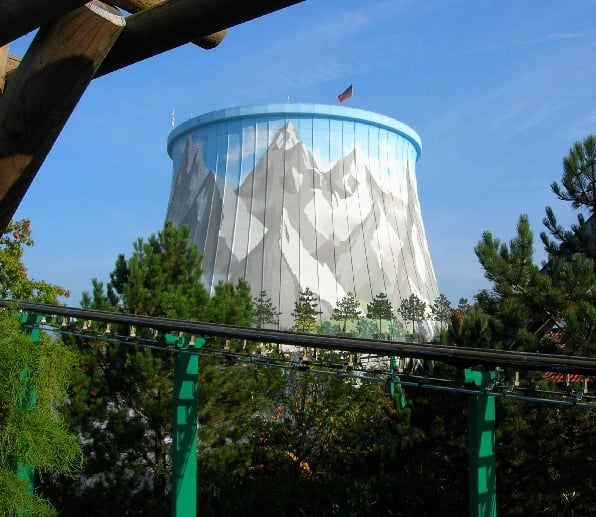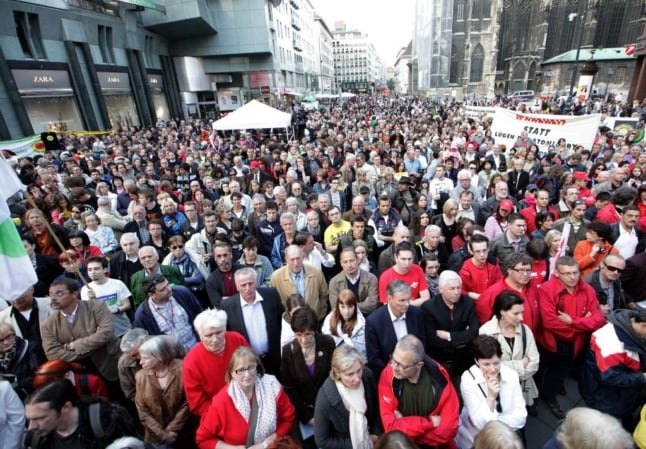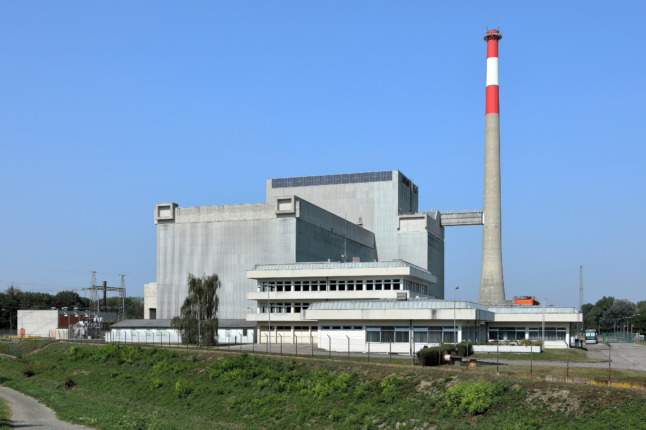Today the plant is used for a variety of purposes. It generates solar power through photovoltaic plates, and is used as a film set and for fashion shows and events. In August it was the location of the Shutdown Festival, with about 13,000 guests dancing to electronic music within its concrete walls.
The site was also used to train German nuclear plant technicians, until Germany decided to phase out nuclear power following the Fukushima nuclear disaster in Japan. Now the plant is used to train people how to close down and decommission reactors safely.
Museum, theme park or cemetery?
Stefan Zach, the press spokesman for the electricity supplier EVN, told The Local that many uses had been proposed for the defunct nuclear site.
The eccentric Austrian artist Friedensreich Hundertwasser, best known for his design of a brightly coloured apartment block in Vienna, hoped to make it into a museum for “misleading technologies”, but this plan was quickly rebuffed by the plant owners.
Architect Robert Rogner wanted it to become a theme park, similar to the Wunderland Kalkar, which is situated in a disused nuclear power plant in Germany. And Austrian aristocrat and convicted murderer Udo Proksch thought the plant should be turned into a vertical graveyard, in which people would be buried upright in glass tubes. Ultimately, none of these ideas were successful.

The Wunderland Kalkar amusement park in Germany. Photo: Kungfuman/Wikimedia Creative Commons
Zach told The Local: “Most recently there was the idea to create escape rooms in the plant, but it was too dangerous. There are 1,050 rooms and the walls are too thick for mobile phone signals. It is too easy to get lost.”
History of anti-nuclear protest in Austria
According to anti-nuclear activist and academic Dr Peter Weish, when the plant was first built in 1977, Austria’s government assumed that the majority of Austrians would be in favour of nuclear power.
However, they had not reckoned with the campaign groups opposed to the Austrian Nuclear Power Plant. Campaigners came from different political and ideological backgrounds, but were on average younger and more educated than the general population in Austria.
In a paper first presented in Japan in the 1980s, titled Austria’s no to nuclear power, Weish writes that the group’s concerns ranged from fears about the release of radioactive materials hazardous to human health to possible connections between what he calls “the so called peaceful nuclear energy and the military nuclear industry”.
A vote in a referendum in Austria in 1978 eventually saw nuclear power rejected by a slim margin – with 49.5 percent voting for the nuclear power plant to be used, and 50.5 percent against. The difference was just 29,469 votes.
However, in December 1978 the National Council (the lower house of Austria’s parliament) decided to ban the operation and construction of nuclear power plants in Austria. Later international events, such as the 1986 Chernobyl nuclear disaster, further hardened opposition to nuclear technology.
‘Lasting paranoia’ from the Cold War
Natalie Marchant, a journalist who covers topics such as climate change for the World Economic Forum, says one reason Austria is unsure about nuclear power could relate to the Chernobyl disaster, which led to clouds floating over Europe releasing radioactive material, or to the secretive nature of the communist eastern bloc, which bordered Austria until the breakdown of the Soviet Empire and the Iron Curtain in the 1990s.
She said: “When Chernobyl happened, there was very little control on what happened beyond the Iron Curtain, and I think that’s left a lasting paranoia.”

In September 2021, environmental organisation Global 2000 found by carrying out tests that mushrooms in Styria and Upper Austria still show traces of radioactivity from contaminated rain as a result of Chernobyl, while the Ministry of Health has also reported on radioactivity in Austrian soil, mushrooms and wild game.
Although Austria does not have any working nuclear reactors within its borders, there are 13 nuclear reactors in countries surrounding the border with Austria within 200 kilometers. Austria was the first country in Europe to set up automatic radiation measuring systems and has kept its warning system of 300 stations in place which measure radiation continuously, its Ministry for the Environment notes.
Early warning system from Cold War still in place
In addition, unlike neighbouring Germany, Austria has kept in place its early warning system from the cold war and has a nationwide, operational network of 8,212 sirens which are tested twice a year. These have most recently been used to warn of flooding, but are also in place to warn of nuclear incidents.

An interesting feature of life in Vienna is that parents are routinely asked to sign consent forms that their children can be given iodine in the event of a nuclear incident when sending their kids to Austrian state kindergartens. Iodine is given to prevent thyroid cancer in the event of a nuclear incident.
Austria’s recently departed Chancellor Sebastian Kurz has repeatedly said he would never allow nuclear power to be generated in Austria, stating in a June 2021 press release that “Austria regards nuclear power as neither sustainable nor safe”. Kurz also tried (unsuccessfully) last year to persuade the Czech Republic, Hungary, Poland and Slovakia to phase out their own reactors.
So without nuclear, what’s the path forward for Austria?
Some argue that Austria can fulfil all its energy needs from renewable sources, such as wind, solar and hydro energy. However, at present, just 75 percent of Austria’s energy needs are generated in this way.
The government has set itself the goal of switching to 100 percent renewable energy by 2030, and earlier this year passed the Renewable Expansion Law in an attempt to facilitate this.
But the Austrian Wind Energy Association has said that in order to achieve that goal, some states will need to generate more than 100 percent of their own power supply, and that becoming 100 percent renewable will require “significantly more speed in the expansion of renewable energies”.
Supporters of nuclear however argue that nuclear should play a part in the move away from fossil fuels.
An article in the Bulletin of the Atomic Scientists, “Don’t let nuclear accidents scare you away from nuclear power”, claims that “in order to reach the goals set out by the 2015 Paris Agreement, nuclear power will need to double its contribution to the global energy mix.”
But in Austria, that would require overcoming its long-standing scepticism.




 Please whitelist us to continue reading.
Please whitelist us to continue reading.
There are no nuclear reactors for power generating purposes, but there are nuclear reactors in the Prater (TU Wien) and Seibersdorf. Worth remembering that such reactors provide a valuable role e.g. for instrument calibration.
Austria’s recently departed Chancellor Sebastian Kurz has repeatedly said he would never allow nuclear power to be generated in Austria, stating in a June 2021 press release that “Austria regards nuclear power as neither sustainable nor safe”.
Nuclear is by far the safest form of power production and the least detrimental to the environment in the long term. There has only ever been 3 accidents, two of which had no fatalities and no illnesses, in the entire history of nuclear energy production. Coal mines still rotinuely kill people and pollution from fossil fuels kill hundreds of thousands every year. Wind and solar are unsightly and cannot meet demands of modern society, not without batteries, batteries made from toxic, rare earth metals that cause terrible environmental damage. New plants are passive safety. They cannot melt down. It is time for Austrians, and many in the world, to get educated on the subject. If we are serious about Climate Change that is.